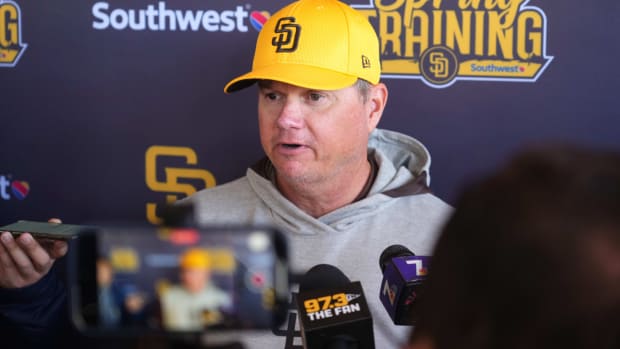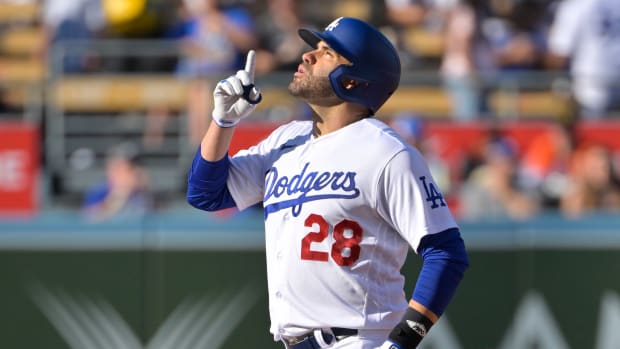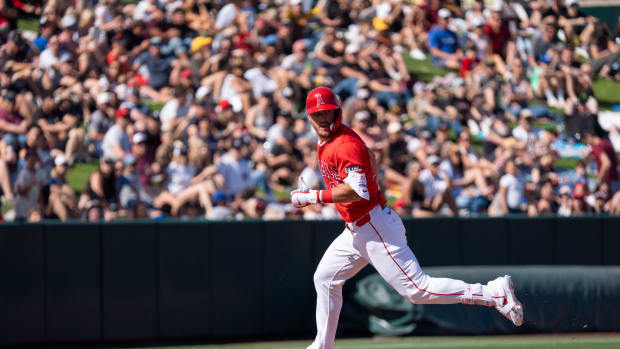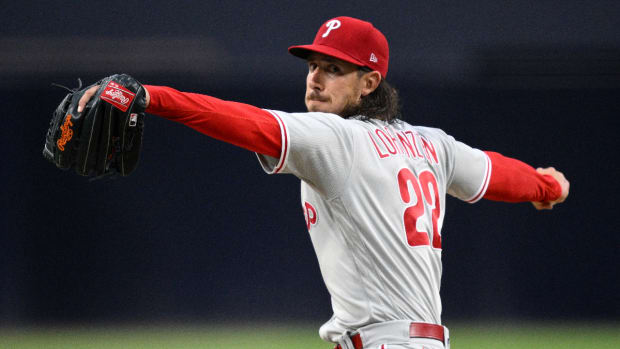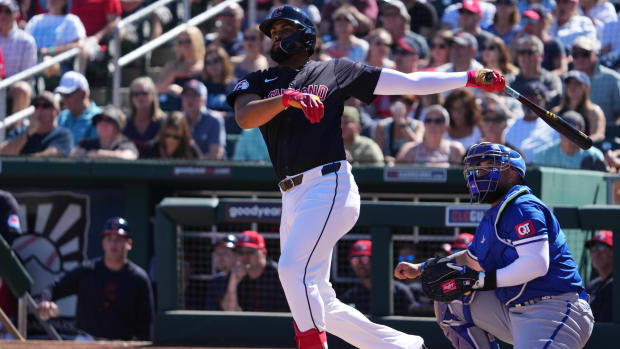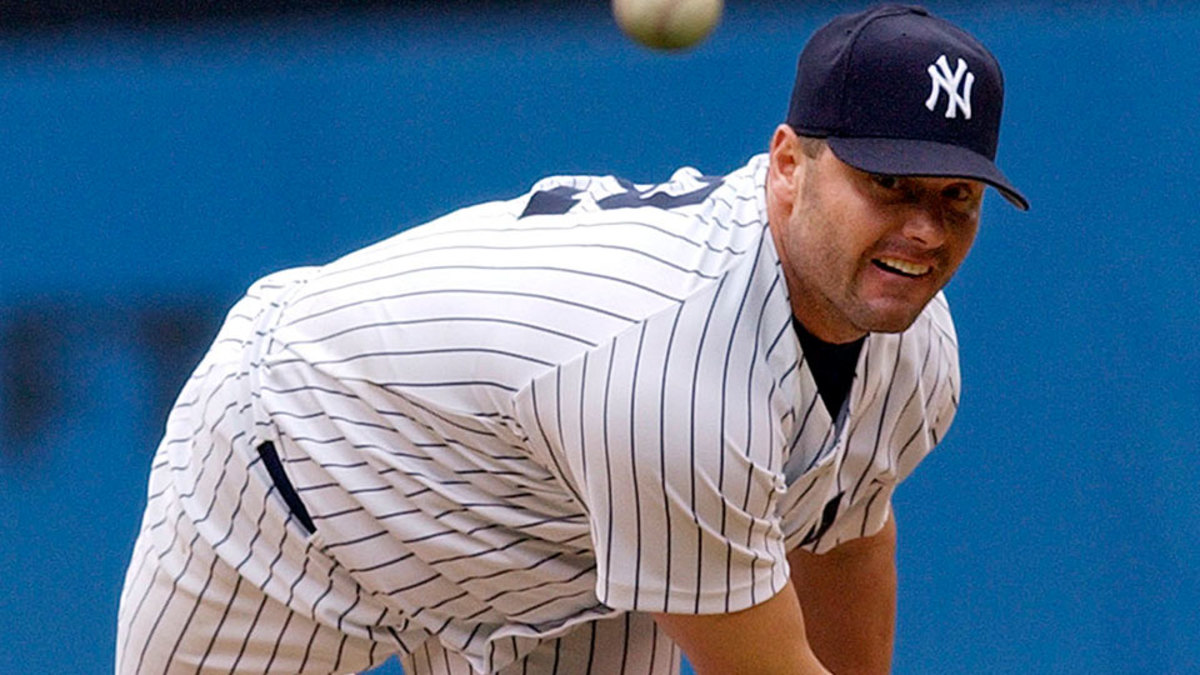
JAWS and the 2016 Hall of Fame ballot: Roger Clemens
The following article is part of my ongoing look at the candidates on the BBWAA 2016 Hall of Fame ballot. Originally written for the 2013 election, it has been updated to reflect recent voting results as well as additional research. For a detailed introduction to this year's ballot, please see here. For an introduction to JAWS, see here.
Roger Clemens has a reasonable claim as the greatest pitcher of all time. Cy Young, Christy Mathewson, Walter Johnson and Grover Cleveland Alexander spent all or most of their careers in the Dead Ball Era, before the home run was a real threat, and pitched while the color line was still in effect, barring some of the game's most talented players from participating. Sandy Koufax and Tom Seaver pitched when scoring levels were much lower and pitchers held a greater advantage. Koufax and 2015 inductees Randy Johnson and Pedro Martinez didn't sustain their greatness for nearly as long. Greg Maddux didn't dominate hitters to nearly the same extent.
Clemens spent 24 years in the majors and racked up a record seven Cy Young awards, not to mention an MVP award. He won 354 games, led his leagues in the Triple Crown categories (wins, strikeouts and ERA) a total of 16 times and helped his teams to six pennants and a pair of world championships.
JAWS and the 2016 Hall of Fame ballot: Introduction to JAWS
Alas, whatever claim "The Rocket" may have on such an exalted title is clouded by suspicions that he used performance-enhancing drugs. When those suspicions came to light in the Mitchell Report in 2007, Clemens took the otherwise unprecedented step of challenging the findings via a Congressional hearing. He nearly painted himself into a legal corner and was subject to a high-profile trial for six counts of perjury, obstruction of justice and making false statements to Congress. After a mistrial in 2011, he was acquitted on all counts the following year. Despite the verdicts, the specter of PEDs won't leave Clemens' case anytime soon, in part because his legal worries aren’t over, even given that in March 2015, he settled the defamation lawsuit filed by former personal trainer Brian McNamee for an unspecified amount.
On a Hall of Fame ballot laden with hitters connected to PEDs—most prominently Barry Bonds, Mark McGwire and Sammy Sosa—it's worth remembering that the chemical arms race involved pitchers as well, leveling the playing field a lot more than some critics of the aforementioned sluggers would admit. The voters certainly haven’t forgotten that when it comes to Clemens, who debuted at 37.6% of the vote in 2013, dropped a couple of points the following year and rebounded to 37.5% in '15—exactly half of the support he needs for election. He's waited his turn behind 2014–15 honorees Johnson, Maddux, Martinez, Tom Glavine and John Smoltz, but with his eligibility period shortened to 10 years, it’s entirely possible his case will wind up in front of the Expansion Era committee.
pitcher | career | peak | jaws | w | l | era | era+ |
Roger Clemens | 140.3 | 55.3 | 103.3 | 354 | 184 | 3.12 | 143 |
Avg. HOF SP | 73.9 | 50.3 | 62.1 |
|
|
|
|
Contrary to legend, Clemens did not emerge whole from the Texas soil. Born in Dayton, Ohio, to parents who separated during his infancy, he didn't move to Houston until high school in 1977. At Spring Woods High, he pitched and played first base in baseball, was a defensive end in football and a center in basketball. After attending San Jacinto College North in 1981, he was drafted by the Mets in the 12th round but chose not to sign. Instead, he left for the University of Texas, earning All-America honors twice and pitching the Longhorns to a College World Series championship in 1983. The Red Sox tabbed him with the 19th pick of that year's draft.
JAWS and the 2016 Hall of Fame ballot: Mike Mussina
After just 17 minor league starts across three levels—all of which he dominated—the 21-year-old Clemens debuted in the majors less than a year later, on May 15, 1984. He went 9–4 with a 4.32 ERA for Boston, but more impressively, he struck out 8.5 hitters per nine in his 133 1/3 innings, a rate better than the official AL leader (Mark Langston, 8.2 per nine). Limited to just 15 starts the following year due to shoulder soreness, he was diagnosed with a torn labrum by a then-obscure orthopedist named Dr. James Andrews, who repaired the tear arthroscopically, a novel treatment for the time.
Eight months later, Clemens was back in action, and at 23, he put together his first outstanding season in 1986. In his fourth start, he set a major league record by striking out 20 Mariners; he didn't walk anyone and allowed just three hits and one run. He wound up leading the AL in wins (24) and ERA (2.48) and ranked second in strikeouts (238) and WAR (8.9). That latter mark trailed only Milwaukee's Teddy Higuera, but Clemens's edge in the traditional numbers and his role in leading Boston to an AL East title helped him capture not only his first Cy Young (unanimously, even) but also league MVP honors.
Clemens made three good starts and two lousy ones in the postseason, throwing seven strong innings in Game 7 of the ALCS against the Angels and departing Game 6 of the World Series against the Mets after seven innings with a 3–2 lead and the Red Sox six outs from their first championship since 1918. Alas, fate intervened in the form of sloppy relief work by Calvin Schiraldi—an ex-college teammate of Clemens's who had been traded to Boston in November 1985—a wild pitch from Bob Stanley and a ground ball through Bill Buckner's legs. You know the rest.
Clemens followed up in 1987 by winning 20 games, tossing seven shutouts among his 18 complete games (!) and racking up 9.4 WAR—league-leading figures in each category—en route to a second straight Cy Young. In 1988, he struck out a league-leading 291 and spun eight shutouts, helping the Sox to another AL East title.
JAWS and the 2016 Hall of Fame ballot: Curt Schilling
His 1989 was less notable (a garden-variety 5.7 WAR season, still good for fourth in the league), but he followed that up in 1990 with the first of three straight ERA crowns; his 1.93 mark that season was less than half of the AL's 3.91 figure. He led the league with 10.6 WAR that year but finished second to Oakland’s Bob Welch in the Cy Young voting; Welch had gone 27–6 with a 2.95 ERA—more than a full run higher, in a much more pitcher-friendly park—in a season worth 3.0 WAR. The Red Sox won the AL East, but after throwing six shutout innings in Game 1 of the ALCS against the Athletics, Clemens was ejected in the second inning of Game 4 by home plate umpire Terry Cooney, who claimed that the pitcher cursed at him and called him "gutless." The ejection came amid a three-run rally that would provide all of the offense the A's needed to complete a four-game sweep.
Clemens won his third AL Cy Young in 1991, leading the league in innings (271 1/3), ERA (2.62), strikeouts (241) and WAR (7.9). The award made him the fifth pitcher to take home at least three Cys, after Koufax, Seaver, Jim Palmer and Steve Carlton, and, at age 29, the first to do so before turning 30. He slipped to third in the voting in 1992 despite leading the AL again in ERA (2.41) and WAR (8.8); that last figure was 0.6 wins more than Cy Young winner Dennis Eckersley and runner-up Jack McDowell combined.
No pitcher threw more innings than Clemens from 1986 to '92 (1,799 1/3), and no one was within 20.0 WAR of him during that span; Frank Viola's 37.7 ranked second to Clemens's 58.4. High mileage began taking its toll, however. Clemens served stints on the disabled list in 1993 (groin) and '95 (shoulder), averaging just 28 starts, 186 innings, 10 wins and 4.5 WAR from '93 to '96—about half his annual value over that previous seven-year stretch.
That said, Clemens’s final year in Boston was actually an outstanding one camouflaged by a 10–13 record and a 3.63 ERA (still a 139 ERA+). He led the league in strikeouts for the third time with 257, and his 242 2/3 innings were his most since 1992. On Sept. 18, in what proved to be his third-to-last start for the Sox, he tied his own major league record by striking out 20 Tigers, again issuing no walks. Despite his ability to consistently fool hitters, Boston general manager Dan Duquette opted to let Clemens depart for the Blue Jays via free agency, famously declaring that the 34-year-old was in "the twilight of his career."
JAWS and the 2016 Hall of Fame ballot: Edgar Martinez
The extent to which that statement fueled the final decade-plus of Clemens's career is an issue taken up further below, but for now we'll stick to the record as it unfolded at the time. In December 1996, the Rocket signed a three-year, $24.75 million deal with Toronto and then put together back-to-back seasons in which he not only won Cy Young awards but also Triple Crowns. His '97 campaign (21–7, 2.05 ERA, 292 strikeouts, 11.9 WAR) was by far the better of the two seasons, though his 8.2 WAR the following year led the league as well. That 11.9 WAR season in '98 ranks fourth among all pitchers since World War I, 0.2 wins behind the totals of Alexander (1920), Carlton (1972) and Dwight Gooden (1985).
Clemens's rebound caught the eye of Yankees owner George Steinbrenner, who had long coveted the now-36-year-old righty. On Feb. 18, 1999, shortly after pitchers and catchers had reported to spring training, the defending world champion Yankees sent starting pitcher David Wells, reliever Graeme Lloyd and reserve infielder Homer Bush to Toronto in exchange for Clemens. Hampered by a hamstring injury, he spent three weeks on the disabled list and posted a 4.60 ERA during the regular season. Clemens fared better in the postseason, save for an early exit against the Red Sox in Game 3 of the ALCS at Fenway Park; his 7 2/3 innings in Game 4 of the World Series against the Braves helped New York complete a sweep to sew up its second straight championship.
Clemens's stint with the Yankees extended four more seasons. Though not as consistently dominant as he was in Toronto, he helped the Joe Torre-led team win pennants in 2000, '01 and '03. In the first of those years, he was knocked around in two Division Series starts by the A's but responded with a 15-strikeout, one-hit shutout of the Mariners in the ALCS and eight innings of shutout ball in Game 2 of the World Series against the Mets. That latter performance was overshadowed by his confrontation with Mike Piazza in which Clemens hurled a broken bat barrel across the slugger's path as he ran down the first base line, with benches emptying and tabloids having a field day.
Aided by outstanding run support (5.7 per game), Clemens won a sixth Cy Young with a 20–3, 3.51 ERA season in 2001, though his 5.6 WAR ranked fourth; teammate Mike Mussina (17–11, 3.15 ERA with an AL-high 7.1 WAR) got a raw deal, finishing fifth in the voting. Clemens struggled early in the postseason, totaling just 13 1/3 innings through his first three starts, but he hit his stride in the World Series. With the Yankees trailing the Diamondbacks 2–games-to-0, he whiffed nine in seven strong innings and allowed just one run in a Game 3 win, then struck out 10 in 6 2/3 innings in Game 7, though New York ultimately lost. After a dud start in Game 7 of the 2003 ALCS against Boston, he had a strong outing against the Marlins in Game 4 of the World Series, but the Yankees fell to Florida in six.
JAWS and the 2016 Hall of Fame ballot: Tim Raines
The 41-year-old Clemens initially retired after that 2003 season, but when friend and former Yankees teammate Andy Pettitte signed with the Astros, he was lured back. Pitching in the NL for the first time, Clemens recovered some of his dominant form, winning his seventh and final Cy Young award in '04 by going 18–4 with a 2.98 ERA and 218 strikeouts, his highest total since 1998. He won yet another ERA crown with a 1.87 mark in 2005. After helping Houston come within one win of a World Series berth in '04 (his six-inning, four-run performance in Game 7 of that year's NLCS wasn't a career highlight), the team won the pennant the following year. Alas, he had just one good postseason start out of three, plus a strong three-inning relief appearance that garnered a win in the Astros' 18-inning Division Series clincher against the Braves. He left the World Series opener against the White Sox after just two innings due to a hamstring strain, and Chicago eventually completed the four-game sweep.
Convinced that his aging body wouldn't withstand the grind of another full season, Clemens continued to dabble with retirement, sitting out spring training and making 19 starts with a 2.30 ERA for Houston in 2006 and 17 with a 4.18 ERA for the Yankees in '07. But any designs the 45-year-old Clemens had on furthering his career were put on hold when he was named in the Mitchell Report that December. Based upon information obtained from McNamee, who served as the Blue Jays' strength and conditioning coach in 1998 and then moved on to the Yankees in 2000, the report alleged that Clemens began using Winstrol (a steroid) in mid-'98 after learning about its benefits via teammate Jose Canseco, and that he used various steroids and human growth hormone in '00 and '01. McNamee, who also served as a personal trainer for Clemens and Pettitte in the 2001–02 offseason, claimed to have performed multiple injections on Clemens and to have stored the used syringes in empty beer cans. In 2012, Pettitte testified that Clemens admitted using HGH in a conversation the two pitchers had in either 1999 or 2000.
Clemens challenged the Mitchell Report, and two months later, he had his day in front of Congress. Seeking to cast doubt on the report and on the testimonies of both Pettitte and McNamee, the Rocket and his counsel went a weak 1 for 3, painting a picture of McNamee as a fairly disreputable character seeking to avoid jail time of his own. The Department of Justice opened a perjury investigation into Clemens's testimony, and in August 2010, he was charged with six felony counts of perjury, obstruction of justice and making false statements to Congress. The case dragged on until June of 2012, when he was acquitted on all counts.
In the summer of 2013, at age 50, Clemens mounted a brief comeback with the Sugar Land Skeeters of the independent Atlantic League, with son Koby catching him in two starts. Despite widespread speculation that he would pitch another game for the Astros—thereby bumping his Hall of Fame eligibility back another five years, distancing himself from the controversy—he did no such thing.
JAWS and the 2016 Hall of Fame ballot: Mike Piazza
There's little question Clemens has the numbers—traditional or sabermetric—for the Hall of Fame. His 354 wins rank ninth all-time, the second-highest total of the post-1960 expansion era behind Maddux's 355. His 4,672 strikeouts rank third behind the totals of Nolan Ryan and Randy Johnson. His seven Cy Young awards are two more than Johnson, three more than Carlton or Maddux and at least four more than any other pitcher. He led his leagues in wins four times and placed in the top five seven other times. He led in ERA seven times and finished in the top five on five other occasions. He led in strikeouts four times, ranked second five times and in the top five 16 times. His 140.3 career WAR ranks third behind Young (168.4) and Walter Johnson (165.6) and is nearly twice the total of the average Hall of Fame starter (73.9). The only other post-World War II pitchers above 100 are Seaver (110.5), Maddux (106.8), Randy Johnson (102.1) and Warren Spahn (100.2). Clemens's 66.3 peak WAR ranks 11th, ahead of every pitcher whose career ended after 1930. His JAWS ranks third behind Walter Johnson and Young; Seaver is the only postwar pitcher within 20 points of his 103.3. To borrow Bill James's praise of Rickey Henderson: Cut Clemens in half and you'd have two Hall of Famers.
The PED allegations muddy the waters, but in my eyes, the timing matters. Clemens never failed a drug test, and the Mitchell Report’s accounts date to the time before MLB began testing players for PEDs or penalizing them; Clemens is not known to have used them once testing was in place. It's also worth noting that the findings of the report didn't hold up in court, with the credibility of star witness McNamee a major problem. That's not to say that Clemens is as pure as the driven snow. He's a reflection of the era in which he pitched, and by the guidelines I've laid out in this series, I don't see anything in his case that puts him in the class of Rafael Palmeiro, whose Hall of Fame-caliber numbers were trumped—at least in the eyes of the voters—by his having failed an MLB-administered drug test.
For those who want to play the "He was a Hall of Famer before he touched the stuff" game, consider just what Clemens did with the Red Sox alone. In 13 seasons with Boston, he notched 192 wins with a 3.06 ERA (144 ERA+) and 2,590 strikeouts; his JAWS line for those years alone (81.3 total/60.4 peak/70.9 JAWS) would be above the Hall of Fame standard for starting pitchers and good for 21st on the list, with a score a whisker below that of Pedro Martinez (84.0/58.2/71.1). That ranking doesn't even include Clemens's Cy Young-winning 1997 performance with Toronto, around which there are no PED allegations.
JAWS and the 2016 Hall of Fame ballot: Jeff Bagwell
The PED connection and the crowd on the ballot have thus far prevented Clemens from entering the Hall, and his wait doesn't figure to end any time soon. Since 1966 (when the BBWAA returned to annual voting), 18 candidates received between 30% and 45% of the vote in their third year of eligibility (this includes Enos Slaughter’s 45.6%). Five besides Clemens are still on the ballot: Barry Bonds, Edgar Martinez, Tim Raines, Curt Schilling and Lee Smith. Eight have since been voted in, three by the BBWAA (Luis Aparicio, Goose Gossage and Jim Rice), four more by the Veterans Committee (Slaughter, Jim Bunning, Johnny Mize and Red Schoendienst). The trio voted in by the writers needed an average of 10 additional years—longer than Clemens has left on the ballot after the Hall's 2014 rule change that truncated the eligibility period from 15 years to 10.
Clemens's credentials are stronger than any of those eight, and the bet here is that eventually, his case will be about those numbers rather than the controversy surrounding them. But between the crowded ballot and the lingering desire of some voters to punish him where the law and MLB couldn't, this Rocket is bound to wait on the launchpad for the foreseeable future.






























